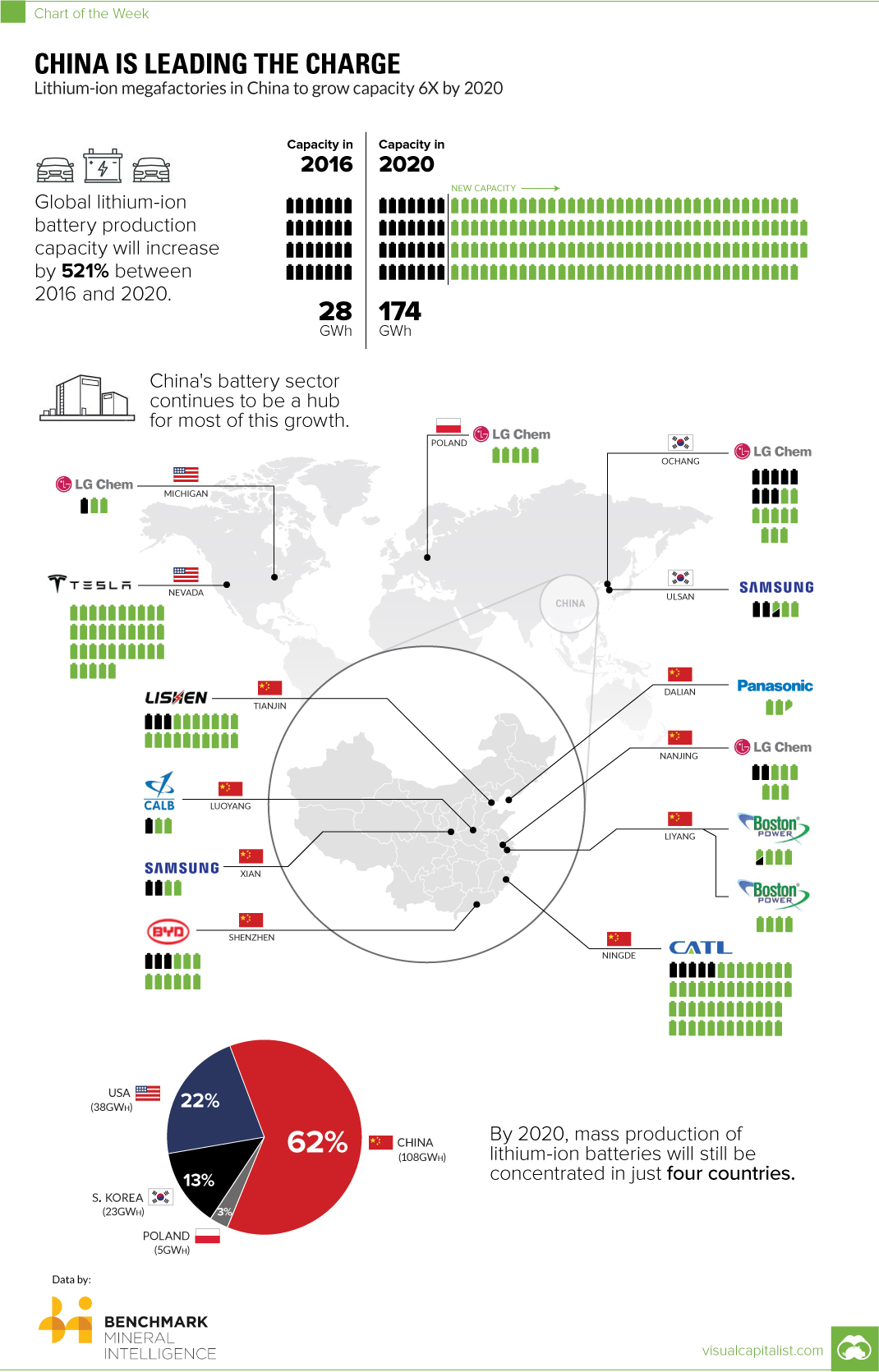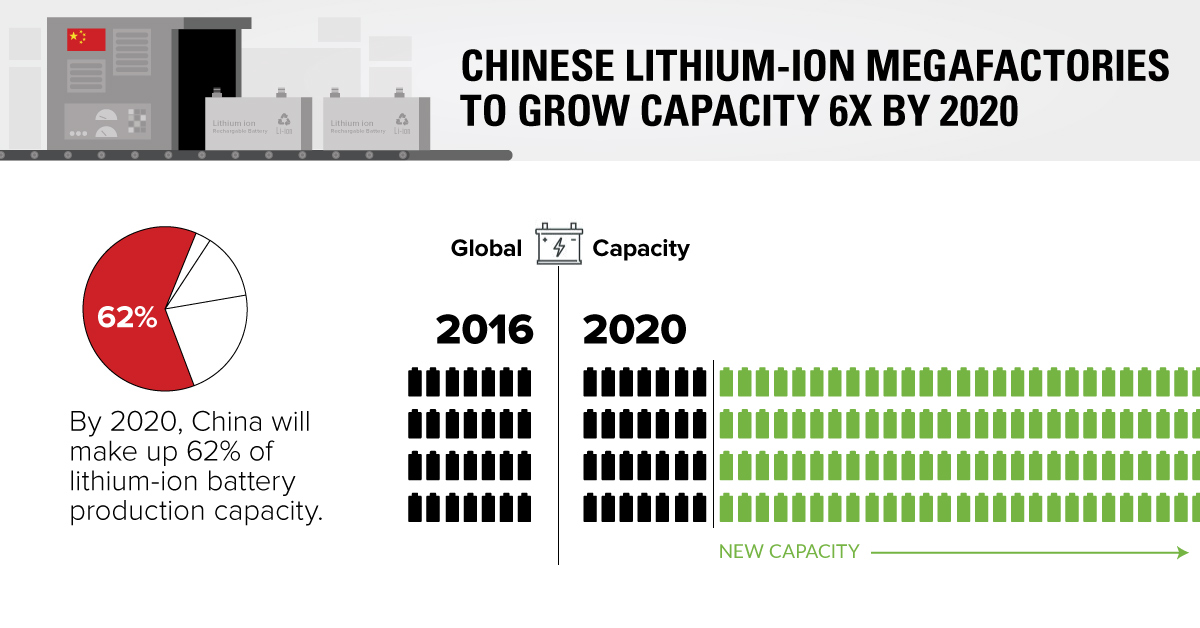Technology
China Leading the Charge for Lithium-Ion Megafactories

China Leading the Charge for Lithium-Ion Megafactories
The Chart of the Week is a weekly Visual Capitalist feature on Fridays.
Tesla’s Gigafactory 1 has been a center of attention for people interested in the growing momentum behind green energy, electric cars, and battery production. Therefore, it is no surprise that this facility was in the news again last month, with Tesla starting to mass produce batteries as it ramps up to its goal of 35GWh of capacity and beyond.
However, as exciting as this project is, it’s actually just one of multiple large-scale “megafactories” being built – with many of them being in China.
China Leading the Charge
We talked to Simon Moores, Managing Director at Benchmark Mineral Intelligence, who explained that Tesla isn’t alone or unique in its ambitions to build lithium-ion batteries at scale:
While the Tesla Gigafactory is vitally important from an EV vertical integration perspective, the majority of new lithium-ion battery capacity is being built in China. Some of these plants are expected to be huge such as the CATL facility at 50GWh – there is little doubt that China’s lithium-ion industry has come of age.
Contemporary Amperex Technology Ltd (CATL) has plans to build the largest lithium-ion megafactory of all – but the company is little known in North America. It’s already worth $11.5 billion, and could be a dominant force globally in the battery sector if it successfully increases its lithium-ion production capacity six-fold to 50GWh by the year 2020.
Other Chinese manufacturers are on a similar trajectory. Panasonic, LG Chem, and Boston Power are building new megafactory plants in China, while companies such as Samsung and BYD are expanding existing ones. All lithium-ion plants in China currently have a capacity of 16.4GWh – but by 2020, they will combine for a total of 107.5GWh.
Capacity by Country
This ramp up in China means that the country will have 62% of the world’s lithium-ion battery production capacity by 2020.
There are only three other players in the megafactory game: United States, South Korea, and Poland.
| 2016 Capacity (GWh) | 2020 Capacity (GWh) | % of Global Total (2020) | |
|---|---|---|---|
| United States | 1.0 | 38.0 | 22% |
| China | 16.4 | 107.5 | 62% |
| Korea | 10.5 | 23.0 | 13% |
| Poland | 0.0 | 5.0 | 3% |
| Total | 27.9 | 173.5 | 100% |
Above estimates on battery capacity courtesy of Benchmark Mineral Intelligence.
Brands
How Tech Logos Have Evolved Over Time
From complete overhauls to more subtle tweaks, these tech logos have had quite a journey. Featuring: Google, Apple, and more.

How Tech Logos Have Evolved Over Time
This was originally posted on our Voronoi app. Download the app for free on iOS or Android and discover incredible data-driven charts from a variety of trusted sources.
One would be hard-pressed to find a company that has never changed its logo. Granted, some brands—like Rolex, IBM, and Coca-Cola—tend to just have more minimalistic updates. But other companies undergo an entire identity change, thus necessitating a full overhaul.
In this graphic, we visualized the evolution of prominent tech companies’ logos over time. All of these brands ranked highly in a Q1 2024 YouGov study of America’s most famous tech brands. The logo changes are sourced from 1000logos.net.
How Many Times Has Google Changed Its Logo?
Google and Facebook share a 98% fame rating according to YouGov. But while Facebook’s rise was captured in The Social Network (2010), Google’s history tends to be a little less lionized in popular culture.
For example, Google was initially called “Backrub” because it analyzed “back links” to understand how important a website was. Since its founding, Google has undergone eight logo changes, finally settling on its current one in 2015.
| Company | Number of Logo Changes |
|---|---|
| 8 | |
| HP | 8 |
| Amazon | 6 |
| Microsoft | 6 |
| Samsung | 6 |
| Apple | 5* |
Note: *Includes color changes. Source: 1000Logos.net
Another fun origin story is Microsoft, which started off as Traf-O-Data, a traffic counter reading company that generated reports for traffic engineers. By 1975, the company was renamed. But it wasn’t until 2012 that Microsoft put the iconic Windows logo—still the most popular desktop operating system—alongside its name.
And then there’s Samsung, which started as a grocery trading store in 1938. Its pivot to electronics started in the 1970s with black and white television sets. For 55 years, the company kept some form of stars from its first logo, until 1993, when the iconic encircled blue Samsung logo debuted.
Finally, Apple’s first logo in 1976 featured Isaac Newton reading under a tree—moments before an apple fell on his head. Two years later, the iconic bitten apple logo would be designed at Steve Jobs’ behest, and it would take another two decades for it to go monochrome.
-

 Green1 week ago
Green1 week agoRanked: The Countries With the Most Air Pollution in 2023
-

 Automotive2 weeks ago
Automotive2 weeks agoAlmost Every EV Stock is Down After Q1 2024
-

 AI2 weeks ago
AI2 weeks agoThe Stock Performance of U.S. Chipmakers So Far in 2024
-

 Markets2 weeks ago
Markets2 weeks agoCharted: Big Four Market Share by S&P 500 Audits
-

 Real Estate2 weeks ago
Real Estate2 weeks agoRanked: The Most Valuable Housing Markets in America
-

 Money2 weeks ago
Money2 weeks agoWhich States Have the Highest Minimum Wage in America?
-

 AI2 weeks ago
AI2 weeks agoRanked: Semiconductor Companies by Industry Revenue Share
-

 Travel2 weeks ago
Travel2 weeks agoRanked: The World’s Top Flight Routes, by Revenue















